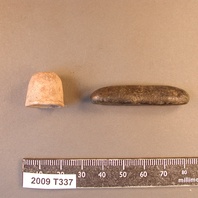
Viking Objects
Breedon Silver Ingot (X.A208.2010.0.0)
A cast silver ingot of typical Viking type. The photograph shows it alongside a lead gaming piece of a type that is increasingly being found within the Danelaw. This ingot could have been used as bullion in payments or trade transactions, as well as a source of metal for jewellery making. This particular ingot has slight irregularities from being made in an open mould and has two testing nicks on one edge. The Vikings arriving in England had a bullion economy where they paid for goods with silver that was weighed to an amount agreed between the buyer and the seller. Hacksilver and silver ingots are the most common evidence for their bullion economy. It took some time for the Scandinavian settlers to adopt a monetary economy like that of the Anglo-Saxons, and both systems were used simultaneously for a while before they fully adopted the new system. They were familiar with monetary economies but they treated coins as just another form of silver before adoption of a monetary economy.
Read More
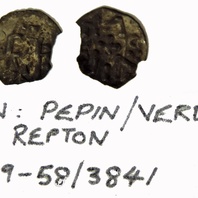
Viking Objects
Coin of Pepin III (1989-58/3841)
This is a silver denier of Pepin III, also known as ‘the Short’ (King of the Franks 751-768), minted at Verdun. The Vikings would have obtained real and imitation Carolingian coins through their raiding and trading activities in the Frankish Empire.
Read More
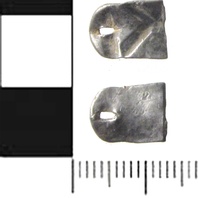
Viking Objects
Mystery Hacksilver
A fragment of silver from an unidentified object. The piece has been pierced at one end but may have come from an armring or other piece of jewellery. As hacksilver, it would have been used to pay for items by weight of silver.
Read More
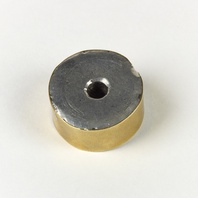
Viking Objects
Reproduction Copper Alloy-Edged Lead Weight
A lead weight edged with a copper alloy band.
Read More
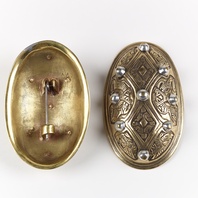
Viking Objects
Reproduction Oval Brooches
Oval brooches were used to fasten dresses in the Viking Age. They are diagnostically Scandinavian and indicate a Scandinavian identity wherever they are found. This pair of brooches is a reproduction of a pair found at Adwick le Street near Doncaster. The mismatched pair were buried with a Norwegian woman who died within a generation of the arrival of the Great Army in the mid-ninth century. Scandinavian brooches came in a variety of sizes and shapes which included disc, trefoil, lozenge, equal-armed, and oval shapes. The different brooch types served a variety of functions in Scandinavian female dress with oval brooches typically being used as shoulder clasps for apron-type dresses and the rest being used to secure an outer garment to an inner shift. Anglo-Saxon brooches do not match this diversity of form with large disc brooches being typical of ninth century dress styles with smaller ones becoming more popular in the later ninth and tenth centuries. However, since disc brooches were used by both Anglo-Saxon and Scandinavian women they are distinguished by their morphology. Scandinavian brooches were typically domed with a hollow back while Anglo-Saxon brooches were usually flat. Moreover, Anglo-Saxon brooches were worn singly without accompanying accessories.
Read More
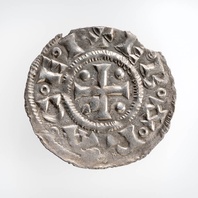
Viking Objects
Northumbrian Viking Penny (CM.952-2000)
This Sword St. Peter type silver penny is not associated with any particular ruler but was minted in the Viking kingdom of Northumbria. The coin features a sword image which is usually considered to represent the sword of St Peter, whose name features on the same side of the coin, and a hammer which is often taken to be Thor’s hammer, thus mixing the iconography of the Christian and Norse religions. It was found as part of the Thurcaston hoard which was probably buried c.923-925 CE, approximately five years after Leicester had been retaken by Mercia (c.918). The coins in the hoard are Anglo-Saxon, Arabic and Danelaw issues, showing the wide-ranging contacts between societies at this time. After the establishment of the Danelaw, some Viking leaders decided to mint their own coins to solidify their legitimacy in the eyes of the local populace. This created a hybrid economy where some members of the Danelaw used bullion and others used coins. The bullion economy resulted in some coins being cut into pieces to pay for items.
Read More
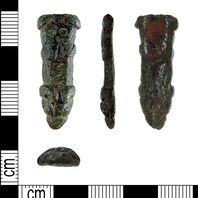
Viking Objects
Copper-Alloy Strap-End (DENO-E40172)
An incomplete copper-alloy strap-end decorated with zoomorphic motifs and stylised human or animal head. It has been identified typologically as belonging to Thomas Class B Type 4.
Read More
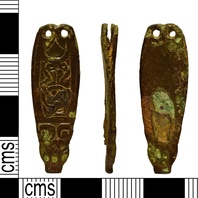
Viking Objects
Copper-Alloy Strap-End (NARC-033287)
An incomplete copper-alloy strap-end classified as Thomas’ Class A, Type 1, with zoomorphic terminal and Trewhiddle-style decoration. The decoration is composed of an incised pattern which depicts two semi-circular ears below which are two triangular eyes to either side of the head can be see, flanked by a forked central brow. The central panel bears Trewhiddle-style decoration depicting a beast with serpentine curvilinear tail.
Read More
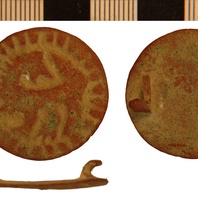
Viking Objects
Brooch with Backwards-Facing Beast (NLM-08BAEB)
It has been suggested that the beast motif on this brooch represents a horse, but identification is uncertain. This brooch was probably the property of an ordinary person rather than of a member of the social elite. It is of a fairly common type. For more information on Scandinavian jewellery in England check out our blog: Brooches, Pendants and Pins: Scandinavian Dress Accessories in England.
Read More
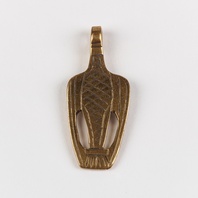
Viking Objects
Reproduction Bird Pendant
A reproduction bird pendant based on one found at Langford, Nottinghamshire. The nearest parallel to this type of brooch is one from Yaroslavl in Russia. The bird symbol, very similar to the one depicted on this pendant, was used by the Rurik dynasty which had started the conquest of Slavic lands in the mid 9th century and later formed the polity of Rus’. With some exceptions, pendants were generally worn by women as an accessory to Scandinavian dress.
